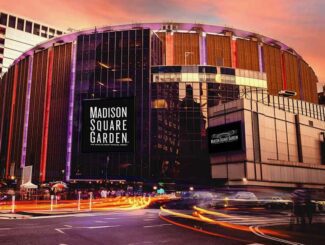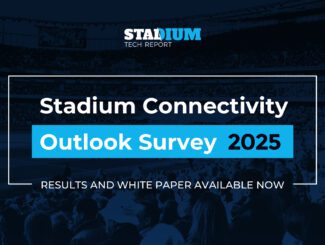
In every NFL stadium, almost all game-critical systems now run on IP networks. Coaching headsets ride dedicated wireless channels. Replay workflows move through cloud infrastructure. Tablets sync real-time images over encrypted links, and control rooms sit on high-capacity fiber backbones supporting thousands of devices at once. Nearly every operational layer inside these venues has converged into a tightly monitored, highly redundant digital environment. Yet in the middle of these modern systems sits a piece of technology that hasn’t changed in decades: the analog “ring-down” telephone attached to each sideline cart.
The handset itself is not the problem. The requirement behind it is. The NFL still mandates hard-wired copper circuits connecting sideline carts to coaching booths, replay rooms, and league operations. That forces stadiums to reintroduce analog pathways into venues specifically designed to avoid single-purpose copper systems. This creates a technical contradiction: venues built as end-to-end IP environments must still support 1980s telephony for one league function. In 2025, that mismatch has become harder to justify and even harder to maintain.
The implications reach far beyond NFL venues. The NFL is the technology bellwether for North American sports, and its standards cascade through other leagues. When architects and consultants design next-generation stadiums, they anticipate NFL requirements first. Those design patterns then extend to MLS, NWSL, USL, MiLB, CFL, and college athletics. A system that persists in NFL specifications almost inevitably persists everywhere else. For the NFL, maintaining legacy analog infrastructure is a minor expense. For mid-tier and lower-tier venues with smaller budgets and leaner operating teams, keeping outdated systems alive diverts money and labor from far more critical upgrades.
Inside NFL stadiums, this analog requirement creates a substantial operational burden. Weekly continuity checks often consume four to ten staff-hours as technicians verify dial tone, routing, endpoint behavior, and cable integrity across multiple locations. On game day, many of these checks are performed again. Failures are common, and the root causes are predictable: oxidized copper pairs, water intrusion into buried conduit, cracked RJ11 terminations, aging patch blocks, or hum and interference along long runs. Analog telephone adapters introduce their own failure modes, including dead ports and failing power supplies. Unlike IP systems, which use redundant switches, VLANs, and wireless pathways, analog circuits offer almost no inherent resilience. When a pair fails, the system fails.
Staffing pressures magnify this problem. Venue IT teams are now built around routing, segmentation, fiber distribution, PoE management, device monitoring, and network reliability. Analog troubleshooting draws on a very different skill set, and many stadiums rely on a shrinking pool of technicians who still understand tone-and-probe work and pair identification. Failures that would be quickly diagnosed in IP systems become time-consuming analog hunts, sometimes occurring during warmups or even mid-game. Operations teams across the league describe the same scenario: maintaining an entire legacy skill set for a device used for a single purpose by a single league.
Architecturally, analog is equally disruptive. The newest NFL stadiums are built as fully converged IP environments, with fiber running to every IDF. Copper exists primarily for short drops or specialty devices. Voice, video, signage, access control, security, replay, broadcast contribution, and building automation all run over segmented VLANs on shared fiber infrastructure. Then the ring-down phone requirement is introduced into the design. Most venues respond by deploying banks of ATAs in MDFs or IDFs, converting SIP to analog, and running dedicated copper through environments explicitly engineered to eliminate that kind of single-use pathway. In many buildings, these are the only analog circuits in operation.
As stadiums undergo periodic renovations, the analog system becomes even more challenging to maintain. Documentation drifts. Labels fade. Legacy spreadsheets go out of sync. Old as-builts become increasingly unreliable as physical paths change. What began as a simple copper pair becomes a scavenger hunt years later. Stadium operators describe spending more time verifying the physical pathway of the analog line than maintaining entire digital subsystems with hundreds of endpoints.
These factors translate into meaningful cost. Copper pathways, conduit, risers, blocks, terminations, and ATA chassis often total $20,000 to $50,000 in initial investment, plus recurring labor costs. Off-season maintenance adds dozens of staff-hours as technicians trace pairs, clean connections, and replace failing segments. Unlike lighting, security, connectivity, or replay infrastructure, these systems do not improve the fan experience, reduce operating cost, or enhance broadcast reliability. They persist because the league has not updated its specifications.
The contradiction becomes more striking when examining league-controlled events. At the Super Bowl, international games, and the Combine, the NFL operates entirely on encrypted VoIP, digital intercom, dedicated VLANs, secure wireless comms, and redundant IP switching. There is no analog fallback kit. The league already trusts IP for its highest-stakes events, across multiple countries and unfamiliar venues. The reliance on analog within home stadiums is therefore not a technical safeguard, but rather a legacy habit.
Modern alternatives outperform analog on every relevant metric. SIP-based ring-down emulation can auto-connect endpoints across isolated VLANs with near-zero latency. IP intercom platforms from RTS and Clear-Com support mission-critical workflows for broadcast teams under far more demanding field conditions than sideline communication. Encrypted VoIP is standard in mission-critical sectors like hospitals, aviation, and finance. Private LTE, already deployed for coaching headsets in many NFL stadiums, can support dedicated voice channels with exceptional reliability. These systems bring redundancy, monitoring, analytics, and centralized control, which are all capabilities that the analog system cannot match.
Analog is also not the only example of legacy infrastructure that survives inside stadium specifications. Triax cabling, once standard for broadcast camera connections, remains in some venue design packages despite most production workflows shifting to SMPTE hybrid fiber or fully IP-based systems. In both cases, the stadium is asked to build and maintain systems whose operational value has largely disappeared.
A modernized sideline system would not require a dramatic redesign. The league could deploy a ruggedized IP handset designed to auto-connect to designated endpoints on an encrypted VLAN. Redundant pathways could be built into the switching architecture. Wireless failover could run on CBRS or Wi-Fi 6E. Centralized monitoring could provide uniform visibility across all 30 venues. Firmware updates, configuration templates, and diagnostics could be standardized at the league level, reducing maintenance burdens, and aligning sideline communication with the rest of the NFL’s technology stack.
If the NFL updates this standard, the benefits extend beyond its own venues. It lowers costs for MLS and NWSL clubs, simplifies operations for minor league baseball and college athletics, and reduces design complexity for integrators and consultants. It also modernizes expectations in publicly funded venues — facilities with limited budgets — while putting pressure on them to keep pace with the technological standards set by professional leagues.
In a sports ecosystem increasingly built on efficiency, resilience, and converged networks, the analog sideline phone is a rare holdover that forces venues to maintain technology they have retired everywhere else. It consumes time, money, and expertise while offering no operational advantage over modern alternatives. The NFL already trusts IP communication for its most important events. The question is no longer whether analog works. It’s whether analog still belongs inside billion-dollar venues built entirely around IP, and whether it still belongs embedded in the design standards that influence every level of sport.






